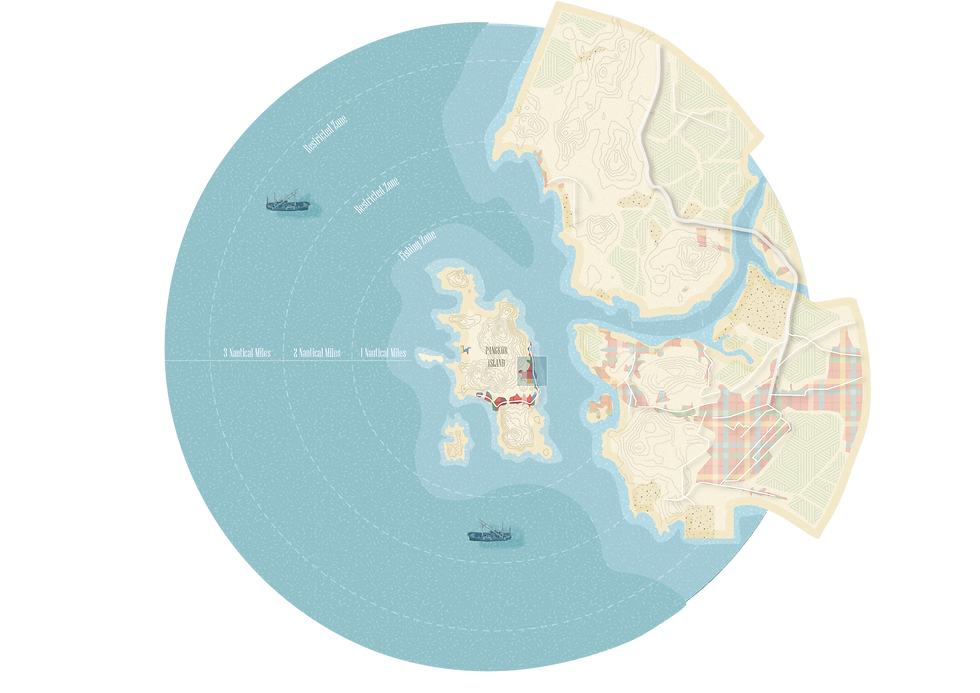Teaching & Learning Engagement in Architecture & Interior Architecture Programs
School of Architecture & Built Environment, UCSI University

"
A ship with an anchor,
Accompanied by fishermen and their nets,
With the rising sun, they begin on their journey,
The sun climbing, the land started the call,
Pangkor, a place of chaos and charm,
Far off the shore beyond,
Whispers of waves upon the sand,
In the distance, it's blending,
Where an island lies ahead,
As boats meet the endless sea,
Where physical limits are tested,
The sun's warm gracing it's presence,
With years of experience guide them through,
Though dangers may lurk, they embrace the challenge,
Questioning whether it's truly safe out there.


After the signing of the Treaty of Nanjing that decreased the restraints on traveling abroad, the Hainanese migrated to Malaysia. The Hainanese start to immigrate to Pangkor. Ikan Kembung is the most famous catch. Using eyes to identify the location of the fish. There are 2 boats, The male and female boats. The male boat is responsible for spreading out the net while the fish that are caught are then transferred onto the female boat and further cooked. In the past, fishermen used the Ni-Siap method by using cotton tread to weave the net. The locals will then dye the net using Tannin dye to make it stronger and tougher. Tannin dye is extracted from local mangrove trees by immersing mangrove trees in the water. This method has been discontinued because nets are bought commercially. However, this was not recorded and cannot be traced.

There are 3 categories of types of boats according to nautical miles. Class A is where a small boat is located to catch anchovies which is around 3 nautical miles from shore. Class B is where the boat sails up to 7 nautical miles from shore and Class C is for deep sea boats, such as trawler nets and big boats up to 70 feet in length which sails 12 nautical miles from shore.
"PANGKOR JOINED THE RANKS OF MALAYSIA’S OTHER DUTY FREE ON JANUARY 1ST, 2020."
-Marco Ferrarese | The West Australian-
As the tourist industry evolves, the younger generations are going out to city areas for better education and career opportunities in hopes of improving their lifestyles. Human resources will be an issue. Some Thoughts from Kim Guan's owners regarding the matter at hand:
"It should be said that is good when there is more tourist, currently government, Pangkor that side (那边的鱼厂全部要拆)and build here because that side wanted to build piers/ docks (码头)and hotels, making changes to it within these five years, then here only consider as a fishing village...
...All the young ones went outstation. They all prefer to go outstation as the salary given here is the same RM1k - 2k++. Mostly is 50 ++ years old uncle auntie here."
"Of course, we are all welcome for tourists entering, but due to some areas have made into tourist areas, the government announced that fishing nets are not allowed to place there."
-Tan Guan Yak-
"The food industry is hardly dead, if we have human resources issues then we have to solve it by maybe getting more foreign workers."
-Tan Wee Hoe-


This is why we have creative archival.


Pangkor is an island situated near the coast of Peninsular Malaysia. It has been known as a fishing village due to its sea related activities. In 2020, Pangkor has been announced as a duty-free island, and efforts have been made to transform some areas of the fishing village into tourist attractions to attract more tourists to understand the local culture
Anchovy . 江鱼仔 . Ikan Bilis .




